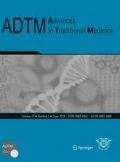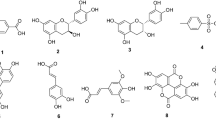Abstract
Annona cherimola Mill., commonly known as Custard apple has recently gained attention of researchers because of copious anticancer bioactive chemicals and nutrients. Plants of the Annonaceae family have a long history of medicinal use in the treatment of several disease conditions such as epilepsy, cardiac diseases, pathogenic infections, hemorrhage, ulcer, cancer, liver disorders and other ailments. Annona cherimola Mill. (Custard apple) is widely used in the traditional and folkloric systems of medicine. It contains numerous bioactive chemicals like annonaceous acetogenins, annocherine A, cherianoine, annocherine B, cherimoline, annomolin, romucosine H, anonaine etc. The fruit of Annona cherimola Mill. is nutritionally important as it contains high amount of carbohydrates and is a rich source of diverse vitamins such as vitamin C, vitamin B6, thiamine, riboflavin and folate. Several phytopharmacological studies have proved and explored medicinal properties of Annona cherimola Mill. Annonaceous acetogenins isolated from the seeds were found to posses potent cytotoxicity against different cancer cell lines. The crude extracts as well as isolated compounds from different plant parts exhibited pharmacological activities such as antidiabetic, antimicrobial, antidepressant, anxiolytic, antiviral, antitumor and cytoprotective. The present review focuses in detail the plant profile, nutritional and traditional uses, phytochemistry, and pharmacological properties of different parts of Annona cherimola Mill. plant.

Similar content being viewed by others
References
Aamir J, Kumari A, Khan MN, Medam SK (2013) Evaluation of the combinational antimicrobial effect of Annona Squamosa and Phoenix dactylifera seeds methanolic extract on standard microbial strains. International Research Journal of Biological Sciences 2:68–73
Adewole SO, Caxton-Martins EA (2006) Morphological changes and hypoglycemic effects of Annona Muricata Linn. (Annonaceae) leaf aqueous extract on pancreatic Β-cells of Streptozotocin-treated diabetic rats. Afr J Biomed Res 9:173–187
Albuquerque TG, Santos F, Sanches-Silva A, Oliveira MB, Bento AC, Costa HS (2014) Nutritional and phytochemical composition of Annona cherimola Mill. fruits and byproducts: potential health benefits. Food Chem 15(193):187–195
Araujo RCP, Neves FAR, Formagio ASN, Kassuya CAL, Stefanello MEA, Souza VV, Pavan FR, Croda J (2014) Evaluation of the anti-mycobacterium tuberculosis activity and in vivo acute toxicity of Annona sylvatic. BMC Complement Altern Med 14(209):1–10
Arun YB, Venkatesh K, Chakrapani P, Rani AR (2011) Phytochemical and pharmacological potential of Annona cherimola - a review. International Journal of Phytomedicine 3:439–447
Barreca D, Lagana G, Ficarra S, Tellone E, Leuzzi U, Galtieri A, Bellocco E (2011) Evaluation of the antioxidant and cytoprotective properties of the exotic fruit Annona cherimola Mill. (Annonaceae). Food Res Int 44:2302–2310
Betancur-Galvis LA, Saez J, Granados H, Salazar A, Ossa JE (1999) Antitumor and antiviral activity of Colombian medicinal plant extracts. Mem Inst Oswaldo Cruz Rio de Janeiro 94(4):531–536
Biba VS, Malar JPW, Remani P (2013) Differential effects of Annona Squamosa seed extracts: antioxidant, antibacterial, cytotoxic and apoptotic study. Int J Pharm Bio Sci 4(2):899–907
Chavan SS, Shamkuwar PB, Damale MG, Pawar DP (2014) A comprehensive review on Annona reticulate. IJPSR 5(1):45–50
Chuang P, Hsieh P, Yang Y, Hua K, Chang F, Shiea J, Wu S, Wu Y (2008) Cyclopeptides with anti-inflammatory activity from seeds of Annona Montana. J Nat Prod 71:1365–1370
Costa EV, Pinheiro SML, Maia BH, Duarte MCT, Amaral ACF, Leon GM (2009) Antimicrobial and antileishmanial activity of essential oil from the leaves of Annona foetida (Annonaceae). Quim Nova 32(1):78–81
Costa EV, Dutra LM, de Jesus HC, Nogueira PC, Moraes VR, Salvador MJ, Cavalcanti SC, dos Santos RL, Prata AP (2011) Chemical composition and antioxidant, antimicrobial, and larvicidal activities of the essential oils of Annona salzmannii and A. pickelii (Annonaceae). Nat Prod Commun 6:907–912
Costa EV, Dutra LM, Nogueira PCL, Moraes VR, Salvadorb MJ, Ribeiro LHG, Gadelha FR (2012) Essential oil from the leaves of Annona vepretorum: chemical composition and bioactivity. Natural Product Communication 7(2):265–266
Costa EV, Cruz PE, Lourenco CC, SouzaMoraes VR, Lima NPC, Salvador MJ (2013a) Antioxidant and antimicrobial activities of aporphinoids and other alkaloids from the bark of Annona salzmannii A. DC. (Annonaceae). Nat Prod Res 27(11):1002–1006
Costa EV, Dutra LM, Salvador MJ, Ribeiro LHG, Gadelha FR, Carvalho JE (2013b) Chemical composition of the essential oils of Annona pickelii and Annona salzmannii (Annonaceae), and their antitumour and trypanocidal activities. Nat Prod Res 27(11):997–1001
Diniz TC, Araujo CS, Silva JC, Oliveira RG, Lima-Saraiva SRG, Quintans LJ, Nunes XP, Almeida JRG (2013) Phytochemical screening and central nervous system effects of ethanolic extract of Annona vepretorum (Annonaceae) in mice. Journal of Medicinal Plants Research 7(37):2729–2735
Elhawary SS, Tantawy ME, Rabeh MA, Fawaz NE (2013) DNA fingerprinting, chemical composition, antitumor and antimicrobial activities of the essential oils and extractives of four Annona species from Egypt. Journal of Natural Sciences Research 3(13):59–68
Fale PL, Ferreira C, Maruzzella F, Florencio MH, Frazao FN, Serralheiro MLM (2013) Evaluation of cholesterol absorption and biosynthesis by decoctions of Annona cherimola leaves. J Ethnopharmacol 150:718–723
Ferreira L, Perestrelo R, Camara JS (2009) Comparative analysis of the volatile fraction from Annona cherimola Mill. cultivars by solid-phase microextraction and gas chromatography–quadrupole mass spectrometry detection. Talanta 77:1087–1096
Gajalakshmi S, Divya R, Deepika VD, Mythili S, Sathiavelu A (2011) Pharmacological activities of Annona Squamosa: a review. International Journal of Pharmaceutical Sciences Review and Research 10(2):24–29
Garcia-Aguirre KK, Zepeda-Vallejo LG, Ramon-Gallegos E, Alvarez-Gonzalez I, Madrigal-Bujaidar E (2008) Genotoxic and cytotoxic effects produced by Acetogenins obtained from Annona cherimolia MILL. Biol Pharm Bull 31(12):2346–2349
Igwe SA, Nwobodo NN (2014) Anticonvulsant activity of aqueous Root extract of Annona Senegalensis Pers. Int J Adv Biol Biomed Res 2(8):2441–2447
Jamkhande PG, Wattamwar AS, Pekamwar SS, Chandak PG (2014a) Antioxidant, antimicrobial activity and in silico PASS prediction of Annona reticulata Linn. Root extract Beni-Suef University Journal of Basic and Applied Sciences 3:140–148
Jamkhande PG, Wattamwar AS, Chandak PG (2014b) In vitro anthelmintic efficacy of ethno-medicinal plant Annona reticulata L. roots against Indian earthworms (Pheretima posthuma). Indian J Nat Prod Resour 5(2):152–157
Kachhawa JBS, Sharma N, Tyagi S, Sharma KK (2012) Screening of stem bark methanol extract of Annona Squamosa for antibacterial activity. Int J Curr Pharm Res 4:48–50
Kedari TS, Khan AA (2014) Guyabano (Annona Muricata): a review of its traditional uses Phytochemistry and pharmacology. American Journal of Research Communication 2(10):247–268
Kim DH, Ma ES, Suk KD, Son JK, Lee JS, Woo MH (2001) Annomolin and Annocherimolin, new cytotoxic Annonaceous Acetogenins from Annona cherimolia seeds. J Nat Prod 64:502–506
Konate A, Sawadogo WR, Dubruc F, Caillard O, Ouedraogo M, Guissou IP (2012) Phytochemical and anticonvulsant properties of Annona senegalensis Pers. (Annonaceae) plant used in Burkina folk medicine to treat epilepsy and convulsions. Br J Pharmacol Toxicol 3:245–250
Lima LARS, Johann S, Cisalpino PS, Pimenta LPS, Boaventura MAD (2011) Antifungal activity of 9-hydroxy-folianin and sucrose octaacetate from the seeds of Annona cornifolia A. St. -Hil. (Annonaceae). Food Res Int 44:2283–2288
Loizzo MR, Tundis R, Bonesi M, Menichini F, Mastellone V, Avallone L, Menichini F (2012) Radical scavenging, antioxidant and metal chelating activities of Annona cherimola Mill. (Cherimoya) peel and pulp in relation to their total phenolic and totalflavonoid contents. J Food Compos Anal 25:179–184
Lopez-Rubalcava C, Pina-Medina A, Estrada-Reyes R, Heinze G, Martinez-Vazquez M (2006) Anxiolytic-like actions of the hexane extract from leaves of Annona cherimolia in two anxiety paradigms: possible involvement of the GABA/benzodiazepine receptor complex. Life Sci 78:730–737
Luciana AR, Lima S, Pimenta LPS, Boaventura MAD (2010) Acetogenins from Annona cornifolia and their antioxidant capacity. Food Chem 122:1129–1138
Luzia DMM, Jorge N (2013) Bioactive substance contents and antioxidant capacity of the lipid fraction of Annona crassiflora Mart. seeds. Ind Crop Prod 42:231–235
Martinez-Vazquez M, Estrada-Reyes R, Escalona AGA, Velazquez IL, Martinez-Mota L, Moreno J, Heinze G (2012) Antidepressant-like effects of an alkaloid extract of the aerial parts of Annona cherimolia in mice. J Ethnopharmacol 139:164–170
Moghadamtousi SZ, Rouhollahi E, Karimian H, Fadaeinasab M, Abdulla MA, Kadir HA (2014) Gastroprotective activity of Annona muricata leaves against ethanol-induced gastric injury in rats via Hsp70/Bax involvement. Drug Des Devel Ther 8:2099–2110
Mustapha AA (2013) Annona senegalensis Persoon: a multipurpose shrub, its phytotherapic, phytopharmacological and phytomedicinal uses. International Journal of Science and Technology 2(12):862–865
Okoye TC, Akah PA, Okoli CO, Ezike AC, Omeje EO, Odoh UE (2012) Antimicrobial effects of a lipophilic fraction and Kaurenoic acid isolated from the root bark extracts of Annona senegalensis. Evid Based Complement Alternat Med 2012:2–10
Padmaja V, Thankamany V, Hara N, Fujimoto Y, Hisham A (1995) Biological activities of Annona glabra. J Ethnopharmacol 48:21–24
Pandey N, Barve D (2011) Phytochemical and pharmacological review on Annona squamosa Linn. Int J Res Pharmaceut Biomed Sci 2(4):1404–1412
Pimenta LPS, Mendonca DD, Pretti DL, Cruz BLD, Leite EA, De-Oliveira MC (2011) Evaluation of In-vivo antitumor activity of Annona crassiflora wood extract. International Journal of Pharmaceutical Sciences and Drug Research 3(3):270–273
Rani RR, Venkatesh K, Chakrapani P, Arunjyothi B, Amareshwari P, Saraswathi S (2011) Indian medicinal plants Anona cherimola, Erythrina indica, Gymnema and Andrographis species - the best cure for diabetes. International conference on Pharmaceutics & Novel Drug Delivery Systems. 2nd world congress on Bioavailability & Bioequivalence: Pharmaceutical R & D Summit-2011. doi:10.4172/1948-593X.10000S1.
Ribeiro SS, Jesus AM, Anjos CS, Silva TB, Santos ADC, Jesus JR, Andrade MS (2012) Evaluation of the cytotoxic activity of some Brazilian medicinal plants. Planta Med 78:1601–1606
Rios MY, Castrejon F, Robledo N, Leon I, Rojas G, Navarro V (2003) Chemical composition and antimicrobial activity of the essential oils from Annona cherimola (Annonaceae). Revista de la Sociedad Quimica de Mexico 47(2):139–142
Rout SP, Kar DM, Mohapatra SB, Swain SP (2013) Anti-hyperglycemic effect Annona reticulata L. leaves on experimental diabetic rat model. Asian Journal of Pharmaceutical and Clinical Research 6(1):56–60
Saranya R, Thirumalai T, Hemalatha M, Balaji R, David E (2013) Pharmacognosy of Enicostemma littorale: a review. Asian Pacific Journal of Tropical Biomedicine 3(1):79–84
Scheldeman X (2002) Distribution and potential of cherimoya (Annona cherimola Mill.) and highland papayas (Vasconcellea spp.) in Ecuador. pp 1–165
Solomon-Wisdom GO, Ugoh SC, Mohammed B (2014) Phytochemical screening and antimicrobial activities of Annona muricata (L) leaf extract. American Journal of Biological, Chemical and Pharmaceutical Sciences 2(1):01–07
Sousa OV, Del-Vechio-Vieira G, Pinho JRG, Alves MS, Kaplan MAC (2011) Pharmacological effects of the hexane and dichloromethane fractions from Annona coriacea Mart. (Annonaceae) leaves. Lat Am J Pharm 30(5):868–873
Udvardy A, Miskovics A, Sipos A (2014) Antibacterial aporphinoids - progress and perspectives based on structure-activity analysis. International Bulletin of Drug Research 4(6):1–34
Vanhove W (2008) Descriptors for cherimoya (Annona cherimola Mill.). Bioversity International and Cherla project, Rome and Malaga
Vanhove W, Damme PV (2013) Value chains of cherimoya (Annona cherimola Mill.) in a centre of diversity and its on-farm conservation implications. Tropical Conservation Science 6(2):158–180
Verma AM, Kumar AP, Kavitha D, Anurag B (2011) Anti denaturation and antioxidant activities of Annona Cherimola In-Vitro. Int J Pharm Bio Sci 2(2):1–6
Wang L, Min B, Li Y, Nakamura N, Qin G, Li C, Hattoria M (2002) Annonaceous Acetogenins from the leaves of Annona Montana. Bioorg Med Chem 10:561–565
Wu Y, Chang G, Duh C, Wang S (1993) Cytotoxic alkaloids of Annona Montana. Phytochemistry 33(2):497–500
Zhang Y, Peng H, Xia G, Wang M, Han Y (2004) Anticancer effect of two diterpenoid compounds isolated from Annona glabra Linn. Acta Pharmacol Sin 25(7):937–942
Acknowledgements
Present study is a part of research project for the partial fulfillment of master degree in Pharmacy. The authors would like to express their sincerest gratitude to Swami Ramanand Teerth Marathwada University Nanded, Maharashtra, India for the grants and facilities that enabled this study to be conducted.
Author information
Authors and Affiliations
Corresponding author
Ethics declarations
Ethical Statement
N/A
Conflict of Interest
The authors declare no conflict of interest.
Rights and permissions
About this article
Cite this article
Jamkhande, P.G., Ajgunde, B.R. & Jadge, D.R. Annona cherimola Mill. (Custard apple): a review on its plant profile, nutritional values, traditional claims and ethnomedicinal properties. Orient Pharm Exp Med 17, 189–201 (2017). https://doi.org/10.1007/s13596-017-0263-0
Received:
Accepted:
Published:
Issue Date:
DOI: https://doi.org/10.1007/s13596-017-0263-0



